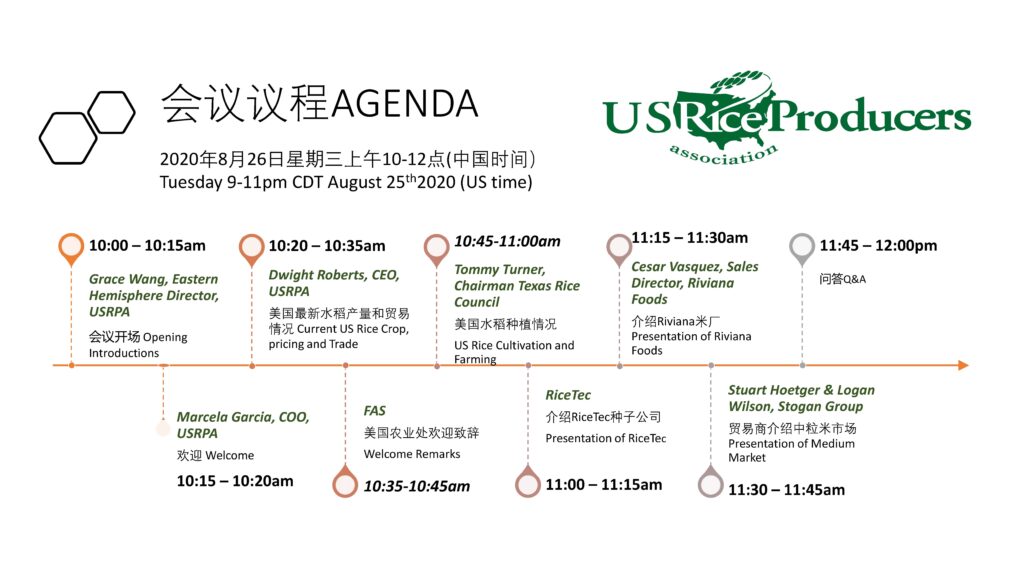Today, December 18, 2020, marks the 23rd anniversary of the founding of the US Rice Producers Association. Today it’s impossible to not think of Mr. Jack Wendt, a Texas rice farmer and former President of the US Rice Council that was based in Houston, Texas, and a man who traveled the world promoting U.S. grown rice. He also made his share of trips to Washington, D.C. to remind Capitol Hill of the contribution made by rice farmers to our national food security in his genuine effort to feed the world.
While Jack grew more than 60 rice crops, he was an original member of the USRPA board of directors. Respected and known by everyone in the U.S. rice industry, Mr. Wendt played an instrumental role in the development of those original by-laws dated December 18, 1997. The same principals installed by Jack in 1997 ring true today- an organization comprised of producers, elected by producers, and representing rice producers in all rice-producing states.
The new rice association was told at the time the effort would never materialize, considered a group of “rebel farmers” who will not last. Someone forgot to tell folks like Mr. Wendt, Raymond Franz, Hal Koop, Sonny Martin, Penn Owen and Rex Morgan apparently. These gentlemen stood by their principals and always spoke as if 1,000 rice farmers were listening over their shoulders. Just like Ray Stoesser!
Over the years change became inevitable and while the USRPA developed unique relationships with the most important markets and the buyers for long-grain rice, it is satisfying to know that these men had so much to do with our current day leadership in the US rice industry.
Comments written last month by the leadership of the USA Rice Federation apparently confirm what these men knew all along.
“All of those issues are long gone and most of the people involved are not around anymore.”
“The leadership on the USA Rice board & committees has changed and the attitude and philosophy has changed.”
“That might have been the case 20 years ago and now is far from the truth.”
Looking back over the past 23 years, this has to be the biggest accomplishment of the USRPA- raising awareness and creating change for the better.
Congratulations to all of you who have been involved in this process and continue to represent rice farmers. 2021 will bring new challenges but like has been the case for the past 23 years, they will be met. After all 2020 has taught us that farmers are officially “essential.”

To accommodate the global travel restriction and adapt to rapidly developing cloud technology, USRPA held its first public virtual event via Zoom in China on Wednesday 10 am -12 pm, August 26th, 2020 (US Central time is Tuesday, August 25, 9-11pm).

The educational seminar on US rice was the first of a series virtual events that benefit both international rice buyers as well as US companies that are particularly interested in expanding their global markets. The seminar attracted dozens attendees in China which primarily consist of rice importers, food processors and Chinese rice industry leaders. This 2 hour event began with a presentation on the latest US rice market and different topics presented by renowned industry speakers followed by a Q&A session. USDA FAS has also accepted the invitation was one of the guest speakers.
China is open to US rice thanks to the efforts of USRPA, the first rice organization to venture into this market. After the successful completion of trade mission in China in 2019, USRPA continues to monitor the market, communicate to trade contacts and plans to conduct promotional programs.

It's time to get excited because the Premier International Rice Conference, Expo, and Networking Event in the Americas is less than 40 days away! We want to extend our gratitude to all the companies that have registered and shown their support for RMTC. Your enthusiasm and commitment to the industry is what makes this event truly special. With so many innovative and inspiring leaders coming together, this conference promises to be an unforgettable experience. We can't wait to see you there! Register Today Register Today |
| Get ready to be rice-spectfully blown away by the incredible lineup of speakers at RMTC this year! From sharing updates on the rice situation in their countries to sprinkling some grains of wisdom, these speakers are set to stir up a storm of knowledge and excitement. So, get ready for a rice-tastic experience like never before! |
 |
| Stuart Hoetger, Co-Founder of The Stogan Group Ricardo Mendoza, General Director of the Mexican Rice Council since 2007 Kamal Dieck, President of Federacion Centroamericana del Arroz (FECARROZ) Sandra Avellaneda, Executive Director of the Induarroz Chamber of ANDI Tiago Barata, Executive Director Sindicato da Indústria do Arroz no Estado do Rio Grande do Sul Oscar Ramirez, President of Asociación de Productores de Arroz de Itapúa (APAI). V “Subra” Subramanian, Co-Founder of SSResource Media |
President Biden Signs Supplemental Funding Package into Law
On Wednesday, President Biden signed into law a package of legislation to provide additional funding to Ukraine, Israel, and Taiwan. The package includes four bills introduced and passed in the House last week. The Senate voted to pass the bills on Tuesday evening. It passed in both chambers on highly bipartisan votes. The package includes $60.8 billion to support Ukraine, $26.4 billion to support Israel, and $8.1 billion to support Taiwan. The package also included a number of policies aimed at enhancing U.S. security against foreign threats.
House Agriculture Committee Aims for a May Markup
Staff for House Agriculture Committee Chairman Glenn “GT” Thompson (R-PA) has been conducting outreach to stakeholders as it prepares for a potential markup next month. The Chairman’s team has been refining their initial proposal based on feedback from their Democratic colleagues on their initial plan in hopes of having bipartisan support among members of the Committee. Current expectations are that the House Agriculture Committee will introduce and mark up a bill the week of May 20 ahead of the congressional recess for Memorial Day.
USDA and USTR Lead Trade Delegation to India
This week, officials from the Department of Agriculture and the Office of the U.S. Trade Representative traveled to India to meet with government officials and private companies in hopes of furthering the trading relationship between the U.S. and India. The U.S. sees India as a key market opportunity for agricultural goods, citing positive movement from India on reducing tariffs on U.S. agricultural imports. While some structural challenges are still in place, U.S. officials expressed optimism for the future relationship between the two countries.
|
|
|
|
|
|
 |
| Guillermo Pesnotti, Co-Founder and CEO of MachVision on "Digital Transformation in the Rice Industry: Quality Control from Intake to Packaging in the Era of Artificial Intelligence and Industry 4.0." Martin Poveda, Senior Director for Rice and Business Affairs at Cibus, on "Application of Gene Editing to Rice Trait Development". J Carlos Olvera, VP of Microbes Biosciences, on "Unleashing the Power or Rice: Naturally-7, a Natural Biofertilizer Revolution." V “Subra” Subramanian, Co-Founder of SSResource Media, on "Indian Ripples, Global Waves & How Global Rice Markets have Responded to Restrictions from India." |
USDA and USAID Announce Investment in Global Food Assistance
On Thursday, USDA and USAID announced an investment of $1 billion in food assistance. $950 million will go towards the purchase of commodities, including rice, to support global food security efforts around the world. The remaining $50 million will be used to purchase commodities not traditionally part of global food assistance programming. Funding through this announcement will support 18 different countries around the world. More information on the announcement can be found here.
Secretary Vilsack Testifies on the USDA Budget Request
On Tuesday, Secretary of Agriculture Tom Vilsack testified before the Senate Agriculture Appropriations Subcommittee on the fiscal year budget request for USDA. In the hearing, members and the Secretary spoke about the importance of protecting rural communities and supporting small and medium-sized farms. Also discussed was the importance of investing in agricultural research. Republican members of the Committee were concerned over the agricultural trade deficit and the loss of farmland for other purposes. A recording of the hearing can be found here. A summary of the hearing can be found here.
Ambassador Tai Testifies on the President’s Trade Agenda
This week the U.S. Trade Representative Katherine Tai testified to both the House Ways and Means Committee and the Senate Finance Committee on the Administration’s trade policy agenda. Republican members expressed concern over how the state of agricultural trade, noting the agricultural trade deficit and ongoing challenges with certain exports such as U.S. rice exports to India which was brought up by Senator Bill Cassidy (R-LA). Members of both parties acknowledged the importance of trade policy to agricultural producers. Ambassador Tai defended the Administration’s trade policy, saying the approach taken supports American families and workers. A recording of the House hearing can be found here and of the Senate hearing can be found here. A summary of the House hearing can be found here and of the Senate hearing can be found here.
| Groundwork is progressing across all states, and this week’s Crop Progress report shows Louisiana is 80% planted and 65% emerged, Texas is 63% planted and 42% emerged, and Arkansas with a huge bump to 46% planted with 7% emerged. Last week reported Arkansas at only 13% planted, and the 5-year average for this time is 17%. The remaining states are Missouri with 35% planted with no rice emerged, Mississippi with 17% planted and 2% emerged, and California still working up the fields with no plantings to date. Overall, the industry is 44% planted, which is nearly double the pace of the 5-year average of 26%. With a tight paddy supply and planting underway, the spot market is firm when rice can be found. But with the producers focused on planting, activity has been more than the last few weeks and is expected to continue in this fashion until planting is largely complete. Prices are reported at $16/cwt in Mississippi, Arkansas, and Missouri, $18.52/cwt in Louisiana, and $19/cwt in Texas. The milled market is steady but could use another tender from Iraq. The good news is the banking problems have caught the attention of the necessary parties in Washington, we are monitoring the situation and expectant for a solution to resume trade.The window between the old crop and the 2024 harvest is reflected in current paddy export prices which are the highest in recent years. Low milling yields resulted in the churning through of higher volumes by U.S. mills to obtain the whole grains and last fall the U.S. was the only source of paddy in the hemisphere, a market condition that had never been seen as Mercosur supplies were too tight. Once farmers finish spring planting, the final stocks still in the bins will be sold, making room for new crops. With the 2024 Brazilian & South American harvest underway, many buyers expected lower prices and an ample supply, but that is just not happening. Blamed on excessive rains and adverse weather conditions, the harvest is very late maturing and field yields are coming in lower than anticipated. The result is another first, like currently in the U.S., Mercosur exporters are lacking competitive FOB prices as well and are largely out of the market. Uncertainty in the marketplace is a constant theme at the moment. We mentioned the emerging issue in Costa Rica last week, and a GAIN report was just published this week and outlines potentially optimistic news that may be able to help supplement the void left by Iraq. Recall that Costa Rica reinstated 35% tariffs on non-U.S.-origin rice. There has been significant red tape because of cyber-attacks, Executive Decrees, and the simple politicization of food security. April 11 was supposed to be the day on which resolution would take place, but was further delayed now to the end of April. It is expected, that if the situation can be resolved and the market returns to “normal,” the U.S. could resume its exports to Costa Rica in the amount of 75,000 metric tons if not more. This would be significant because U.S. rice exports were only 7,200 MT in 2023. In Asia, prices are still hovering just below $600 pmt and don’t show signs of dropping further. Thai prices are right at about $590 pmt, and Viet prices are slightly higher but below $600. Many were expecting a softening to emerge at the beginning of Q2 as India’s export ban has been expected to be removed, if not relaxed in some form. The Indian government has been quiet on its intentions to modify the ban in any way, therefore extending the firmness in price and the necessity to source products from any origin but India for the time being. The election starts today, April 19, and carries on for seven weeks; it will be interesting to see the position as the weeks roll by. The weekly USDA Export Sales report shows sales of 5,900 MT—a marketing-year low—were down 88% from the previous week and 94% from the prior 4-week average. Exports of 51,100 MT were down 16% from the previous week and 42% from the prior 4-week average. |
 |
